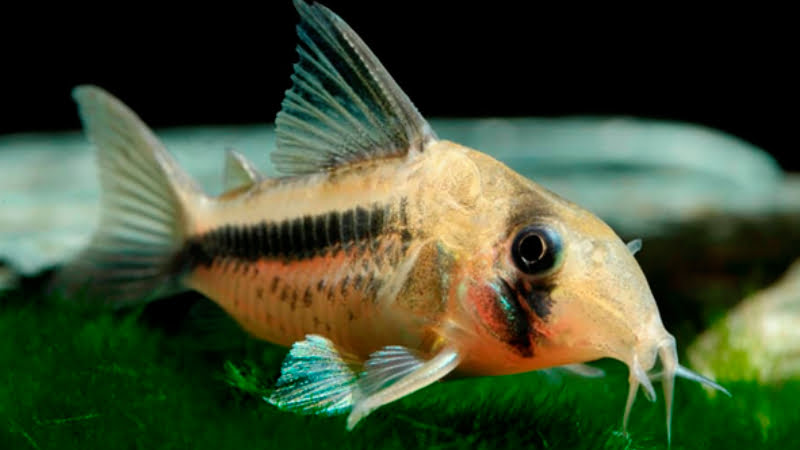The pink cory catfish, or pink corydoras for short, is one of the most visually appealing species among catfish. Besides their unique and beautiful coloration, they are great freshwater community tank members because of their peaceful nature. Also, they’re very sociable and fun to have around.
In this article, I’ll go over all the information you need to know about this catfish, including its distribution, appearance, sexing, caring, and more.
Overview
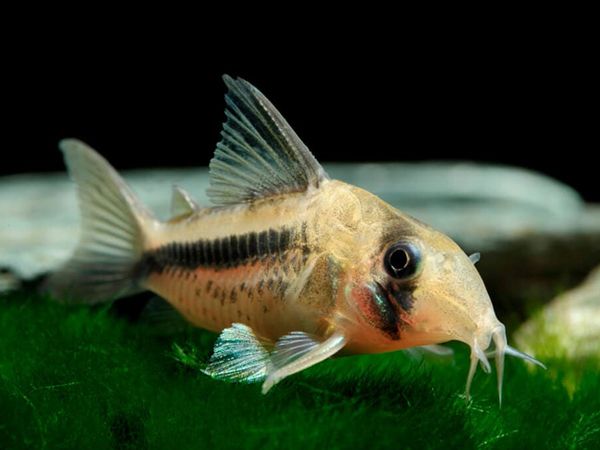
- Scientific name: Corydoras axelrodi
- Common name: Pink cory catfish/ Pink corydoras
- Family: Callichthyidae
- Typical fish tank size: 4 – 5 cm (1.57 – 1.97 inch)
- The range of pH recommended for the species: 6.1 – 7.5
- Water hardness recommendation (dGH): 7 – 20°N (125 – 357.14ppm)
- Temperature recommendation: 22 – 27 °C (71.6 – 80.6°F)
- The method of reproduction: spawning
- Origin: South America
- The temperament: peaceful
- Attitude toward other species of fish: peaceful
- Typical tank location: Bottom levels
Distribution
The pink corydoras, scientifically known as Corydoras axelrodi, is a tropical freshwater fish that is a member of the family Callichthyidae, specifically the subfamily Corydoradinae. It is said to have originated in the interior waters of South America and may be found in the basin of the Meta River in Colombia. This species can grow up to 4.2 cm in length.
Appearance
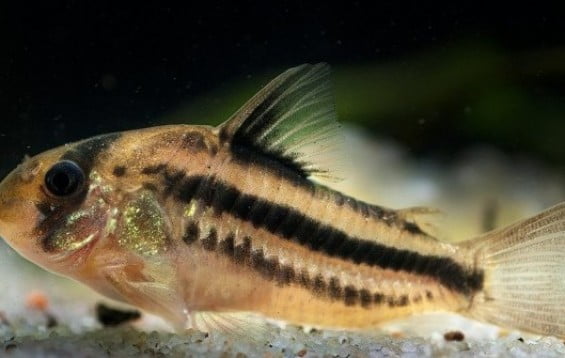
Pink cory catfish are more often referred to by their scientific name, corydoras axelrodi. The species of fish are suitable for keeping in community aquariums. They have a short length to their bodies. The size range of a Corydoras axelrodi is around 1.7 inches (4.2 cm). They are recognized to be ray-finned species since they are members of the class Actinopterygii. They are recognized to be ray-finned species since they are members of the class Actinopterygii.
The fins of pink cory catfish are very stunning. The dorsal fin is fairly big and is covered in a variety of bright colors. In general, the dorsal fin is black with a translucent top section. They feature two pairs of pectoral and pelvic fins that are pinkish in color and are mainly translucent. These fins are located on their ventral side.
On their body, just above their lateral line segment organ, there is a thick black line that runs from side to side. Their heads are big and narrow, and there is an additional black stripe that runs over the region of the forehead just above the eyes.
On the rest of their bodies, the color is almost light pink. In addition, on their gills and some parts of their bodies, they have a shimmering gold sheen.
Sexing
There is no one term that can be used to refer to either the male or the female of this species in a distinct or special way. These fishes exhibit sexual dimorphism in their appearance. Male pink corydoras tend to be smaller in size compared to their female counterparts. Furthermore, the bodies of male corydoras are more elongated and flat, whilst the bodies of female corydoras are more spherical in form.
Caring
Food
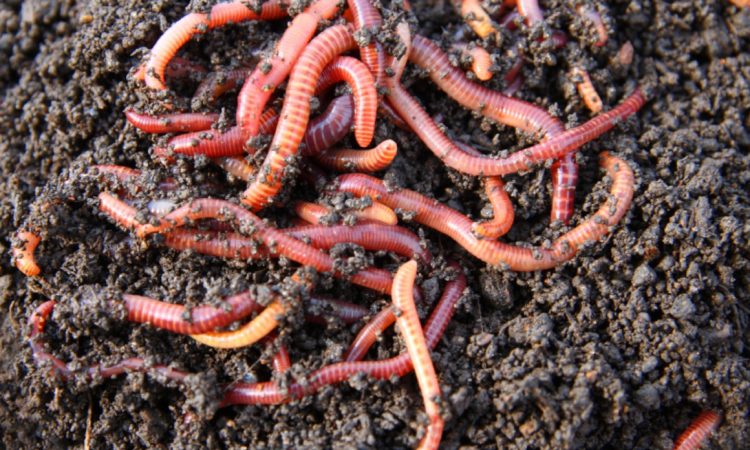
Pink cory catfish is a primarily omnivorous species. They will often consume everything and everything that is present at the bottom of their living environment. And because of their eating pattern, they are simple to care for and feed when kept in an aquarium.
When they are in their native environment, they eat things like worms, shrimp, larvae, insects, planktons, aquatic plants, and any fruits or vegetables that have fallen down. And once they are inside the tank, they continue to consume their food despite the condition it is in.
They can eat food that has been frozen, dried, or even at room temperature. And if the aquarist really wants to show them some extra love, they may feed them blood worms or brine shrimp as a special treat. They devour items that are located at the bottom, most of which are insects. They do not consume any other kinds of fish.
How to feed
You have a lot of dietary options to choose from for your corydoras. However, they will only eat food that is on the substrate at the bottom of the tank. Therefore, it is necessary for them to have access to their food at this location. Bottom pellets, which are available for purchase, are an excellent foundation for the food they consume on a regular basis.
This diet may be supplemented with additional servings of vegetables (spinach and poached salad, sliced cucumbers, etc.). Take away any food that has been left uneaten in the evening.
It is important to keep in mind that, like the other members of its species, the pink cory catfish enjoys eating live or frozen bloodworms very much.
If at all feasible, divide up your daily ration into two halves: one out in the morning and the other in the evening.
The pink cory catfish requires a very specialized diet. If you notice that your Corydora fish are having trouble eating because the other fish in the tank are more agile, try feeding them while the lights are turned off and see how effectively they consume their food.
Reproduction/ Breeding
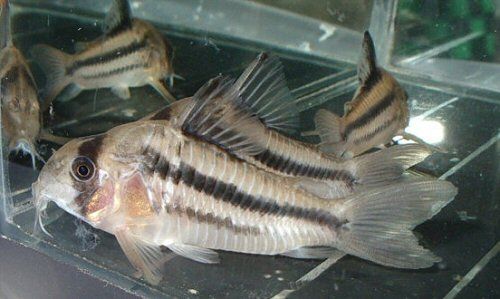
The pink corydoras species are known to reproduce in freshwater environments. They don’t seem to have a set breeding season. When the female and male corydoras axelrodi decide that they are ready enough to breed, they do so.
How to begin breeding
Your corydoras should be around 3/4 of a year old before you attempt to breed them for best results. Take note that the thickness of the eggs increases with the age of the female producing them. They are thus more immune to the effects of the environment and have a greater chance of succeeding, which results in a significant increase in the number of fry.
If you want your corydoras to breed successfully, you should understand that it is essential to house them from the very beginning in a suitable and properly maintained aquarium. This will ensure that they are able to live for as long as possible. This is also necessary for consistent and successful breeding in terms of both quantity and quality.
Breeding tank set up
Installing a breeding tank with a capacity of 50 to 100 liters (11 to 22 imperial gallons or 13 to 26 US gallons) will help ensure that the greatest number of young Corydoras survive.
The temperature of the water should be 20 to 22 degrees Celsius (68 to 72 degrees Fahrenheit), and the optimal pH level ranges from 6 to 7.
You can set certain plants in such a way that they will act as a support system for the female while she lays her eggs ( because in case she can not find a place to drop these eggs, she will refuse spawning). Additionally, adding a compact air diffuser or filter to give power and oxygenate the water in the system is advisable.
Breeding method
Introduce some males in exchange for one female that has been conditioned (live or frozen food). In order to bring the temperature of the aquarium down by a few degrees, you should make a thorough water change using water that is both cooler and gentler. In most cases, reproduction won’t start until the next day. If this is not the case, you will need to carry out the procedure once again the next day.
Another option is to carefully collect the eggs after they have been laid and then transfer them to an aquarium that is designed specifically for the raising of fry.
Eggs may be treated with methylene blue to increase their level of safety, although doing so is not required.
Breeding process
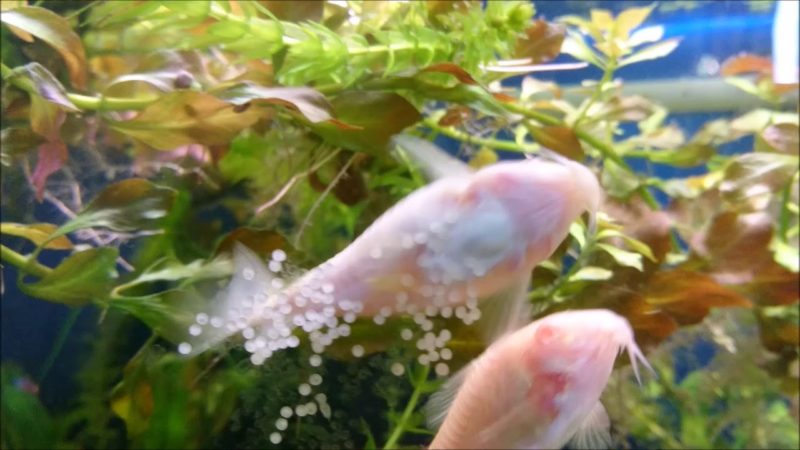
At the time of reproduction, the female holds her eggs between her tail fins, where the male arrives and fertilizes them. Then, after the eggs have been fertilized, the female looks for a suitable location and deposits them there before continuing her quest. The eggs are placed in an incubator for a period of three to four days, after which the fry will come out.
The aquarist has to keep a few factors in mind in order to successfully artificially stimulate the spawning process. Firstly, the bottom of the aquarium should be adorned tastefully with a variety of miniature plants. The gravel and the plants provide the fish with an adequate area to reproduce in an unrestricted manner. Secondly, the spawning process is accelerated in water that has a lower temperature. Last but not least, as soon as the eggs have been deposited, the parents should be removed from the tank as soon as possible. The fry may be seen after a few days have passed in the cooler temperatures.
Three to four days are required for the incubation of the eggs. On a substrate consisting of fine sand (in a thin coating), fry seems to be less sensitive to illnesses than they are when they are on bare soil.
Food for frying includes artemia nauplii, infusoria, and finely crushed dry flakes.
Behavior
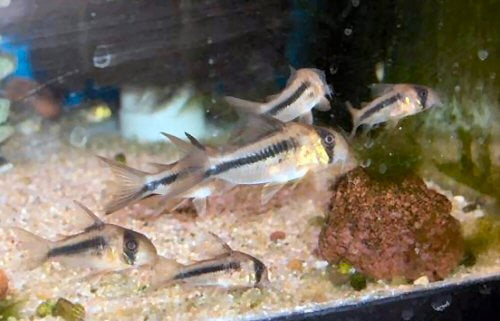
Pink cory catfish is a fish that lives in the bottom of the tank, much like all other species of corydoras. Despite this, it enjoys exerting itself by swimming against the stream whenever it can. You will see it doing this in the central area of the tank or around the windows.
Its intraspecific and interspecific interactions are particularly excellent because they are discrete, tranquil, and peaceful.
In order to satisfy its gregarious drive, a pink cory catfish must cohabit with at least five other members of its own species (in the wild, corydoras may form groups consisting of thousands of individuals!). It is only under these circumstances that your fish will be able to thrive in your aquarium and feel at ease there. Concerning this particular issue, it is estimated that:
- A group of 6 to 8 pink cory catfish: strict minimum
- A group of 9 to 13 pink cory catfish: correct viability
- A group of more than 14 pink cory catfish: behavior similar to natural
They spend the majority of their time feverishly churning through the ground in an attempt to find food or a place to rest.
If you notice that your corydoras are entirely inactive during the day, this might be the result of an issue with cohabitation (where other species are making the corydoras feel threatened), too few individuals, an inadequate aquarium, or a current that is too strong. By checking these points, you will be able to see corydoras activating even during the day.
You may get the corydoras used to your presence even if they are quite scared of you by treating them gently and being patient with them. To do this, you need constantly move extremely slowly and have a very calm demeanor. When your corydoras do not try to escape from you, it is a sign that you have achieved a level of satisfaction, security, and confidence that is far higher than the average!
Tankmates
Since the pink cory catfish ignores the other inhabitants of the aquarium, they will be able to dwell in a communal aquarium.
Corydoras are often frightened by species that are either too bright or too large; thus, it is important to choose roommates that are extremely quiet. For instance, Ember Tetra will make wonderful companions in the tank.
It is best to avoid living with a Common Pleco that is 30 cm or 12 inches in length since it inhabits the same space as a little Corydoras and has the potential to inflict serious injury. In a similar vein, the presence of additional bottom species creates a stressful environment for corydoras by way of increased food competition.
It is best not to mix various species of corydoras together. In point of fact, even if it does sometimes happen that two different species of Corydoras “merge” to create a group, this phenomenon is still rather uncommon. For this reason, a Pink Corydoras and a Corydoras panda ( for instance) will not be able to create a group. Therefore, you should keep them apart from other gregarious bottom fish. Naturally, if you have an aquarium that is spacious enough, you may keep two different kinds of corydoras, each of which will establish its own community.
Video: Corydoras Axelrodi Spawning
FAQs
How big is a pink cory catfish?
The pink corydora is a type of fish that is rather tiny. They are quite short when measured along their length. Their average body length is around 1.7 inches (4.2 cm).
How fast can a pink cory catfish swim?
Pink corydoras, commonly known as Corydoras axelrodi, are fish that are native to freshwater environments but may also be found in aquariums. They are nimble and quick in their natural environment, but the precise speed at which they swim has never been measured.
Are pink cory catfish aggressive?
They’re not aggressive at all, that’s for sure. Instead, they are fish known for their gentle and tranquil demeanor. These fish do not pose any problems for the owner of the tank.
Will pink cory catfish make a good pet?
Absolutely, I think this fish would make a wonderful pet. They are kind and placid fish that don’t bother anybody and spend their time lazily swimming about in their aquariums. They are not the least bit aggressive and never throw any temper tantrums. However, in order to maintain them in excellent health, it is extremely necessary to keep them in a group of at least six to eight fish with a steady supply of food. This will ensure that they remain in the best possible form.

Annette M. Chaney is an experienced marine biologist with over 20 years of experience as an aquarist and fishkeeper. She started her first aquarium at a young age, filling it with frogs and goldfish obtained from the ten-cent pet store.
Annette grew up caring for and breeding African Cichlids, which led to a hobby in high school that doubled as a profitable means. Attending Reed College gave her time to solidify herself as an accomplished aquarium caretaker with an eye for sales. After that, from 2009 – 2013, she studied at Roger Williams University – one of the most prestigious universities for Aquaculture and Aquarium in USA. She is the founder of AquariumCircle since 2010.
